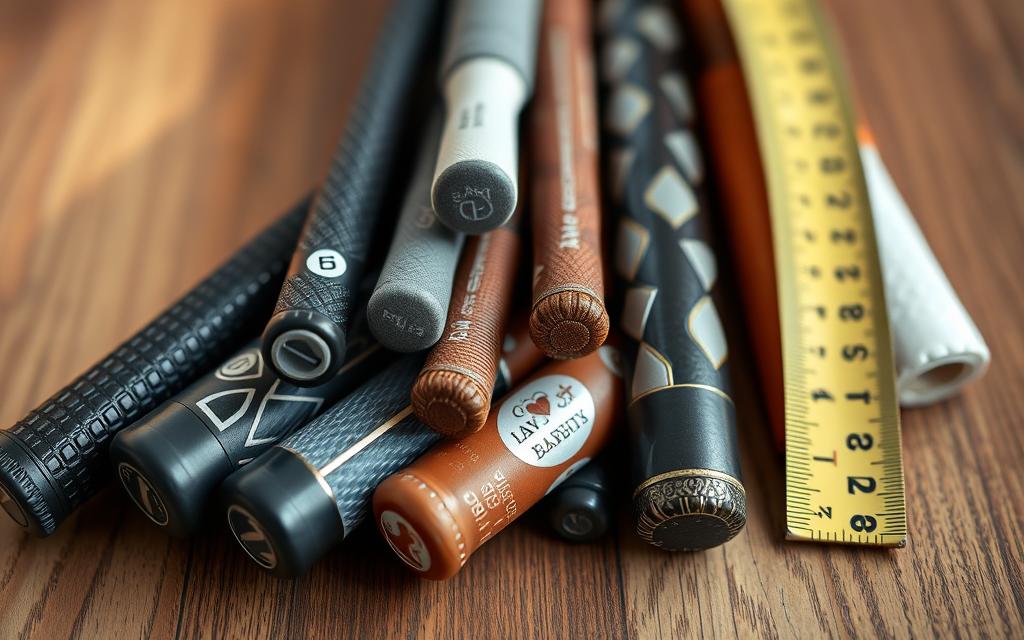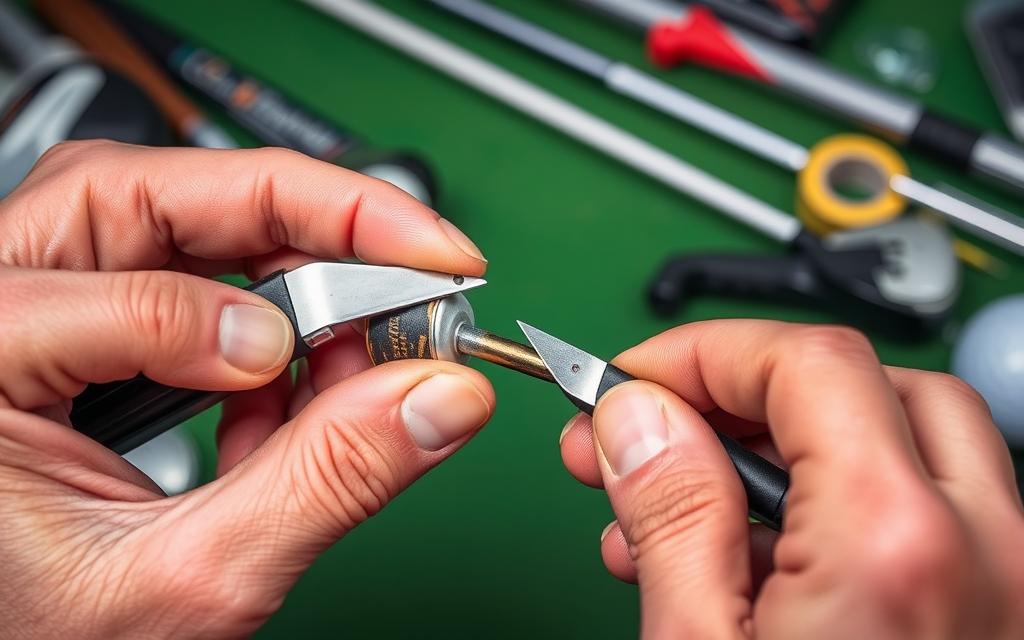As a golfer, you know how key a good grip is. It’s the only part of you that touches the club. It affects your swing, how the ball flies, and your game’s success. So, if your grip is old, slippery, or feels off, it’s time for a change.
Ever thought, What are the signs that indicate it’s time to regrip your clubs? Knowing when to replace your grips keeps your game sharp and comfortable. This guide will show you how to change your golf club’s grip. We’ll cover why grip matters, picking the right one, and how to install it correctly.
Key Takeaways
- A proper golf grip is key for your swing, ball flight, and game success.
- Worn, slippery, or bad grips hurt your game and need to be swapped out.
- Choosing the right grip material and size is vital for comfort and control.
- Removing the old grip carefully and installing the new one right ensures a strong hold.
- Looking after your golf grips can make them last longer and keep your clubs in great shape.
Understanding the Importance of Golf Grip
A perfect golf swing starts with your grip. A good grip is key to your game. It affects your swing and how you control the ball. Without it, your game can be off.
What a Proper Grip Does for Your Game
A proper grip brings many benefits:
- It helps you control the club better.
- You’ll hit the ball more accurately.
- You can hit the ball farther.
- It also helps prevent injuries.
Signs You Need to Change Your Grip
Even the best grips wear out. Look for these signs to change your worn golf grips:
- Cracks or tears in the grip.
- It slips too much during your swing.
- The grip doesn’t fit your hand right.
- It’s not sticky anymore.
Fixing grip issues can make your game better. Understanding your grip is key to better scores and fun play.
Selecting the Right Grip for Your Club
Choosing the right golf grip is important. The material and size of the grip affect your game. Let’s look at the different materials and how to find the right size for you.
Grip Material Options: Rubber, Cord, and More
Golf grips come in many materials, each with its own benefits. The most common include:
- Rubber Grips: These grips are tacky and non-slip. They absorb shock and vibration, making them popular.
- Cord Grips: With a textured surface, cord grips offer great traction. They’re good in wet weather.
- Hybrid Grips: These grips mix rubber and cord features. They offer comfort and control.
Think about what you like, the weather, and how much feedback you want from your clubs when choosing a grip material.
Choosing the Correct Size for Your Hand
Finding the right grip size is key for comfort and performance. Measure from the base of your palm to the tip of your middle finger. This will help you pick the right size, which ranges from undersized to jumbo.
“Selecting the right grip size can make a significant difference in your swing mechanics and overall golf experience.”
With the right grip size, you’ll swing more comfortably and consistently. This leads to better shots and lower scores.

Tools You Will Need for the Replacement
Getting ready for a golf club regripping project means having the right tools. It doesn’t matter if you’re experienced or new. Knowing the essential and optional tools makes the job easier and ensures success.
Essential Tools for the Job
For regripping golf clubs, you’ll need a few key tools. You’ll need a hook blade to take off the old grip. Also, grip tape to get the shaft ready, and a solvent to clean the shaft before putting on the new grip.
Optional Tools That Can Make It Easier
- A vise or clamp to keep the club steady while regripping
- A grip solvent applicator to spread the solvent evenly on the shaft
- A grip stretcher or air compressor to help put the new grip on
- A heat gun to soften the grip for easier installation
The essential tools are a must for a good regripping job. But, the optional tools can make it even better and look more professional. Think about your budget and skill level before choosing extra tools for your golf club regripping project.
Having the right regripping golf clubs DIY tools is key. It can make the difference between a smooth job and a tough one. Take your time to get all the tools you need. This will help you improve your golf clubs’ feel and performance.
Removing the Old Grip
Getting your golf club ready for a new grip is key. Before you can put on the new one, you must take off the old. This guide will show you how to clean the shaft and remove the old grip safely.
Cleaning the Shaft Before Removal
First, clean the shaft of your golf club well. Use a degreaser or rubbing alcohol to get rid of dirt and old grip residue. This makes the new grip stick better and fit securely. Make sure to clean it well for the best results.
Techniques for Safer Removal
- Get your tools ready, like a utility knife, grip solvent, and a grip removal tool. These tools help you remove the grip safely.
- Put grip solvent around the old grip’s base. Let it sit for a few minutes to break the adhesive.
- Use the grip removal tool to gently pry the grip off. Be careful not to push too hard and damage the shaft.
- If the grip doesn’t come off easily, use a utility knife to cut it. Be careful not to scratch the shaft.
- Throw away the old grip and clean the shaft again. This makes sure it’s ready for the new grip.
By following these steps, you can safely remove the old grip without harming your club. With a clean shaft, you’re ready to put on the new grip and play again.
For more tips and guidance on regripping golf clubs, visit [https://progolfstudy.com/privacy-policy/].

Applying the New Grip
Changing your golf club grip is easy, but you must prepare the new grip right. Make sure it fits well on the shaft. This will make your game better and more comfortable.
Preparing the New Grip
Start by getting the surface ready. Put a thin layer of grip tape or solvent on the shaft. Let it dry before you do anything else.
How to Position the Grip Correctly
When putting the new grip on, think about the proper golf grip size. Make sure the grip is right, with the logo or pattern facing the right way. Slide it on carefully, without twisting it.
After it’s on, press the grip firmly onto the shaft. This gets rid of air pockets and makes it smooth. You’ll have a grip that feels good and works well.
Getting the grip right is key for a good swing. By preparing and installing it correctly, you’ll enjoy golf more and play better.
Tips for Ensuring a Proper Installation
Replacing golf grips is a fun DIY task. But, making sure it’s done right is key. When regripping golf clubs, focus on the grip’s alignment. Also, check for bubbles or wrinkles that could hurt your game.
Making Sure the Grip is Aligned
Getting the grip right is vital for good ball striking and control. Take your time to place the new grip correctly. Use marks or a torque wrench to make sure it’s centered and feels right in your hand.
Checking for Any Bubbles or Wrinkles
As you put the new grip on, look out for air bubbles or wrinkles. These can mess up your feel and grip. Use your fingers to smooth out the grip as you install it.
By following these tips, you can get a grip that’s as good as a pro’s. It will boost your game and give you the confidence to play better. Remember, taking care of your grip is important for your best game.
“A properly installed grip can make a significant difference in your golf game, allowing you to swing with confidence and control.”
Maintaining Your Golf Grips
Keeping your golf grips in good shape is key to playing well. A few easy steps can help your clubs last longer. Clean them often, store them right, and replace them when needed.
How to Extend the Life of Your Grips
First, wash your hands before playing. Dirt, oil, and sweat can damage your grips. Also, don’t put wet grips in your bag. This can make them wear out faster.
When to Replace Your Golf Grips Again
How often you need new grips depends on how much you play. Most people should change them once a year. But, if you play a lot, you might need to do it more often.
Watch for signs like cracks or a slippery feel. If your grips don’t feel right, it’s time for new ones.


